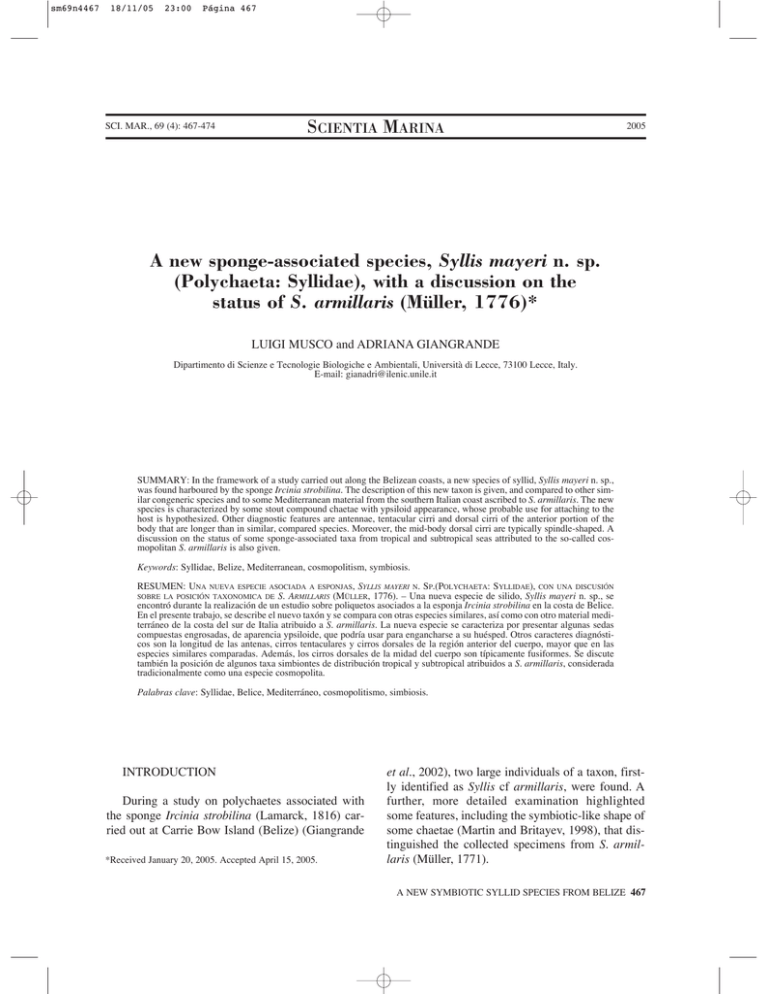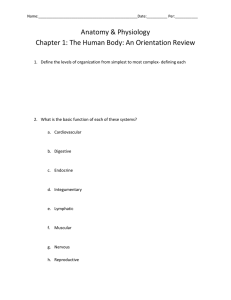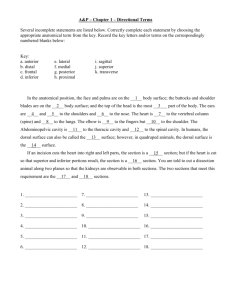S M Syllis mayeri (Polychaeta: Syllidae), with a discussion on the
advertisement

sm69n4467 18/11/05 23:00 Página 467 SCI. MAR., 69 (4): 467-474 SCIENTIA MARINA 2005 A new sponge-associated species, Syllis mayeri n. sp. (Polychaeta: Syllidae), with a discussion on the status of S. armillaris (Müller, 1776)* LUIGI MUSCO and ADRIANA GIANGRANDE Dipartimento di Scienze e Tecnologie Biologiche e Ambientali, Università di Lecce, 73100 Lecce, Italy. E-mail: gianadri@ilenic.unile.it SUMMARY: In the framework of a study carried out along the Belizean coasts, a new species of syllid, Syllis mayeri n. sp., was found harboured by the sponge Ircinia strobilina. The description of this new taxon is given, and compared to other similar congeneric species and to some Mediterranean material from the southern Italian coast ascribed to S. armillaris. The new species is characterized by some stout compound chaetae with ypsiloid appearance, whose probable use for attaching to the host is hypothesized. Other diagnostic features are antennae, tentacular cirri and dorsal cirri of the anterior portion of the body that are longer than in similar, compared species. Moreover, the mid-body dorsal cirri are typically spindle-shaped. A discussion on the status of some sponge-associated taxa from tropical and subtropical seas attributed to the so-called cosmopolitan S. armillaris is also given. Keywords: Syllidae, Belize, Mediterranean, cosmopolitism, symbiosis. RESUMEN: UNA NUEVA ESPECIE ASOCIADA A ESPONJAS, SYLLIS MAYERI N. SP.(POLYCHAETA: SYLLIDAE), CON UNA DISCUSIÓN SOBRE LA POSICIÓN TAXONOMICA DE S. ARMILLARIS (MÜLLER, 1776). – Una nueva especie de silido, Syllis mayeri n. sp., se encontró durante la realización de un estudio sobre poliquetos asociados a la esponja Ircinia strobilina en la costa de Belice. En el presente trabajo, se describe el nuevo taxón y se compara con otras especies similares, así como con otro material mediterráneo de la costa del sur de Italia atribuido a S. armillaris. La nueva especie se caracteriza por presentar algunas sedas compuestas engrosadas, de aparencia ypsiloide, que podría usar para engancharse a su huésped. Otros caracteres diagnósticos son la longitud de las antenas, cirros tentaculares y cirros dorsales de la región anterior del cuerpo, mayor que en las especies similares comparadas. Además, los cirros dorsales de la midad del cuerpo son típicamente fusiformes. Se discute también la posición de algunos taxa simbiontes de distribución tropical y subtropical atribuidos a S. armillaris, considerada tradicionalmente como una especie cosmopolita. Palabras clave: Syllidae, Belice, Mediterráneo, cosmopolitismo, simbiosis. INTRODUCTION During a study on polychaetes associated with the sponge Ircinia strobilina (Lamarck, 1816) carried out at Carrie Bow Island (Belize) (Giangrande *Received January 20, 2005. Accepted April 15, 2005. et al., 2002), two large individuals of a taxon, firstly identified as Syllis cf armillaris, were found. A further, more detailed examination highlighted some features, including the symbiotic-like shape of some chaetae (Martin and Britayev, 1998), that distinguished the collected specimens from S. armillaris (Müller, 1771). A NEW SYMBIOTIC SYLLID SPECIES FROM BELIZE 467 sm69n4467 18/11/05 23:00 Página 468 Syllis armillaris, however, is a problematic taxon. The species was initially described in Arctic waters (Greenland), and is currently considered to be a cosmopolitan form (Licher, 1999; Uebelacker, 1984). However, some descriptions of taxa assigned to S. armillaris markedly differ from each other and from Licher’s (1999) re-description of the species. This is the reason why López et al. (2001) proposed the existence of a sibling-speciescomplex, thus criticizing its so-called cosmopolitan distribution. The species has also been reported widely distributed along the Italian coast, inhabiting photophilic hard substrata with algal covering (Castelli et al., 1995). It has been considered a herbivorous form (Giangrande et al., 2000). In the present paper, in addition to the description of the new species from Belize, we compared it to some Mediterranean material from the southern Italian coast ascribed to S. armillaris. MATERIAL AND METHODS The material from Carrie Bow Island, Belize was sorted from the sponge Ircinia strobilina, collected in July 2001 in the sub-littoral zone at 15 m depth by SCUBA-divers. Samples were fixed with 10% formalin, sorted under a stereomicroscope and then preserved in 70% ethanol. One specimen was chosen as the holotype and deposited in the Museo Nacional de Ciencias Naturales de Madrid (MNCNM). For scanning electron microscope (SEM) observations, one preserved worm was washed three times in distilled water (30 min each), run through a series of ethanol ending with 100%, critical-point dried, attached to a stub and coated with gold. SEM observation was carried out at the University of Genoa and all the images were captured and stored in digital format. The study was also based on preserved specimens of S. armillaris which were deposited within the authors’ personal collection in the Dipartimento di Scienze e Tecnologie Biologiche e Ambientali of the University of Lecce (Italy). The material was collected from Torre Inserraglio (Nardò, southern Italy, Ionian Sea) in July 2003 by scraping off the hard substrate at 1 m depth, on photophilic algal substratum using SCUBA-diving. Samples were fixed in 10% formalin, sorted under a stereomicroscope and then preserved in 70% ethanol. Drawings were obtained using a camera lucida. 468 L. MUSCO and A. GIANGRANDE TAXONOMIC ACCOUNT Family SYLLIDAE Grube, 1850 Subfamily SYLLINAE Grube, 1850 Genus Syllis Lamarck, 1818 Syllis mayeri n. sp. (Figs. 1-3) Material examined: 2 specimens from Carrie Bow Island (Belize), 15 m depth, on July 2001, within Ircinia strobilina (Lamark, 1816), Renata Manconi coll. Holotype: MNCNM catalogue number 16.01/10263. Paratype: under preparation for SEM, in the authors’ personal collection. Type locality: Carrie Bow Island, Belize. Description: Body cylindrical and slender, narrowing towards prostomium and pygidium; brownish, without colour marks; 24 mm long and 0.6 mm wide at proventricle level without parapodia (0.8 mm at chaetiger 26); 163 chaetigers (Figs. 1a, c). Prostomium (Fig. 1b) oval to rounded; palps long, somewhat ovoid, fused at bases; 4 lensed eyes in open trapezoidal arrangement; 3 antennae with triangular arrangement at insertion; median antenna with about 20 articles, and lateral ones with 14 articles. Tentacular segment (peristomium) rectangular and shorter than subsequent segment. Tentacular cirri very long; dorsal ones with 34-35 articles and ventral ones with 19-20 articles. Pharynx long, 1.9 mm (14 chaetigers) and 0.20 mm wide with a relatively large, sub-romboidal, anterior tooth. Proventricle shorter than pharynx, 1 mm in length (7 chaetigers) and 0.37 mm wide, with 33 muscle cell rows. Dorsal cirri of anterior segments long, alternating 30-20 articles; dorsal cirri from proventricular region short, with only 7-9 articles (Fig. 3f), becoming shorter and spindle-shaped from mid-body (Fig. 1d, 3e). Ventral cirri slender and digitiform (Fig. 3d). Parapodia conical, with 7-9 compound chaetae on anterior chaetigers, 7-8 on mid-body chaetigers, and 4-5 on posterior ones. Blade lengths ranging from 41 µm of dorsalmost to 21 µm of ventral-most, with distinct dorsoventral gradation in the anterior region (Figs. 2a-d, 3a). Gradation progressively less marked (Fig. 3b) towards mid-body (starting from about chaetiger 35) with all blades short and stout, measuring about 20 µm, without gradation, and having an ypsiloid appearance on some parapodia (Figs. 2f-h, 3c). Falcigers of posterior parapodia return again to a shape similar to the anterior ones, with dorso-ventral gradation (Figs. 2j-l), but slender (34.4 µm longest blades, 25 µm middle ones, and 18 µm shortest sm69n4467 18/11/05 23:00 Página 469 FIG. 1. – Syllis mayeri n. sp.(a) anterior end, dorsal view; (b) prostomium; (c) pygidium; (d) dorsal cirrus, mid-body. ones). Tip of chaetae clearly bidentate on anterior and posterior falcigers, but much less clear at midbody; sub-distal tooth almost disappears in very short, stout blades, giving them a unidentate appearance. Dorsal (Fig. 2m) and ventral (Fig. 2n) simple bidentate chaetae, both starting from chaetiger 147; ventral being present until last chaetiger, dorsal one disappearing after chaetiger 151. Aciculae stout emerging from the chaetigers in mid-posterior parapodia, numbering 4 in the anterior chaetigers, 2, very different in sizes, in mid-body, and solitary in the posterior parapodia (Fig. 2e, i, o). Pygidium with two lateral anal cirri, with 12 articles, and a median, not articulate, digitiform appendage (Fig. 1c). Ecology: The new species was found in the canals of the sponge Ircinia strobilina collected in the sub-littoral zone at 15 m depth. Etymology: We would like to name the new species after Alexander M. H. Mayer, a young artist and friend, recently deceased. A NEW SYMBIOTIC SYLLID SPECIES FROM BELIZE 469 sm69n4467 18/11/05 23:00 Página 470 FIG. 2. – Syllis mayeri n. sp.(a-d) chaetae, anterior parapodia; (e) aciculae, anterior parapodia; (f-h) stout chaetae, mid-body; (i) aciculae, mid-body; (j-l) chaetae, posterior parapodia; (m) dorsal simple chaeta; (n) same, ventral (o) acicula, posterior parapodia. Remarks: The slender appearance of the anterior segments, of one of the specimens examined could indicate the presence of asexual reproduction, as already observed in related taxa (López et al., 2001). The two individuals examined showed a variation in the length of the blade. The stout compound chaetae of the middle portion of the body was slightly shorter and more clearly ypsiloid in the specimen utilized for SEM analysis. The presence of these chaetae could be an indication of the life-style of the species. Similar chaetae are present in other symbiotic syllids, as well as in other symbiotic polychaetes belonging to other families. Stout blades could, in fact, be useful for attaching to the host (Martin and Britayev, 1998). However, it is hard to infer a strict relation between structure and function. Similar chaetae (or stout, secondary simple chaetae; e.g. S. gracilis, S. ferrani, S. amica) are also present in other syllids not considered symbiotic, but which also inhabit a large range of habitats apart from living organisms (San Martín, 2003). 470 L. MUSCO and A. GIANGRANDE Ypsiloid chaeta is one of the features that distinguish S. mayeri n. sp. from S. armillaris (Müller, 1771), the species that most closely resembles the new taxon. However, among the congeneric species, Licher (1999) considered a group of different taxa as included in the “armillaris complex”. Syllis mayeri n. sp. roughly resembles the taxa included in this group in the general shape of the aciculae; however, among these species, S. crassicirrata (Treadwell, 1925), S. neglecta Grube, 1870, S. stellaepolaris (Hartmann-Schröder, 1993), and S. valida Grube, 1857, clearly differ in the shape and length of the blades of chaetae. In particular, in the anterior chaetigers, the blades are always shorter than those observed in the new taxon. In addition to blade shape, S. krohnii Ehlers, 1864 and S. ehlersioides (Marenzeller, 1890) differ in the general aspect of the dorsal cirri; in particular, the dorsal cirri from the mid-body are always longer than in S. mayeri n. sp. Syllis violacea (Grube, 1870) always has clearly bidentate chaetae and long and short dorsal cirri alternating all along the body. Syllis hyalina Grube, 1863, resembles S. mayeri n. sp. in the general aspect of the body and in the shape of the anterior chaetae blades, but differs in the length of the antennae, tentacular cirri, and anterior dorsal cirri (always shorter in S. hyalina) and in the number of chaetae per chaetiger (always higher in S. hyalina). Among the species not included in the “armillaris complex”, S. ferrani Alós and San Martín, 1987 shows a similar distributional pattern and shape of the median dorsal cirri, but differs in the presence of the characteristic 8-shaped dorsal colour marks and the typical stout secondary simple chaeta. Syllis gracilis Grube, 1840 resembles the new taxon in the general aspects of the body and in the shape and length of the median dorsal cirri, but differs due to the fusion between the blade and shaft of the stout chaetae of the mid-body (absent in S. mayeri n. sp.), the ovoid ventral cirri (digitiform and slender in S. mayeri n. sp.) and the shorter tentacular cirri and anterior dorsal cirri. However, the strong likeness between the new species and S. armillaris requires a deeper analysis. Apart from the presence of the peculiar ypsiloid stout chaeta, other differences distinguish the new taxon from S. armillaris. Among these are: the length of the antennae, the tentacular cirri and dorsal cirri of the anterior portion of the body are longer in the new taxon; the more marked spindle-shape of the posterior dorsal cirri; the length of the pharynx, which is longer in the new taxon, also showing a sm69n4467 18/11/05 23:00 Página 471 FIG. 3. – Syllis mayeri n. sp. SEM photos. (a) chaetae, anterior parapodia; (b) same, proventricular region; (c) same, mid-body; (d) ventral cirri; (e) dorsal cirri, mid-body; (f) same, proventricular region. A NEW SYMBIOTIC SYLLID SPECIES FROM BELIZE 471 sm69n4467 18/11/05 23:00 Página 472 FIG. 4. – Syllis armillaris. (Müller, 1771). (a) prostomium; (b) dorsal cirrus, mid-body; (c-e) chaetae, anterior parapodia; (f) aciculae, anterior parapodia; (g,h) chaetae, mid-body; (i) aciculae, mid-body. Specimen from southern Italy. bigger faringeal tooth; the length of the blades, that in the new taxon are always longer in all chaetal kinds. The new species measurements were compared to similarly sized specimens of Licher’s (1999) re-description. Syllis armillaris (Müller, 1771) (Fig. 4) Nereis armillaris Müller, 1771; Typosyllis armillaris (Müller): Licher, 1999 Material examined: 31 specimens (preserved in 70% ethanol in the authors’ collection), collected on July 2003 from 1 m depth, on photophilic algal substratum at Torre Inserraglio (Nardò, southern Italy, Ionian Sea). 472 L. MUSCO and A. GIANGRANDE Description: Largest specimen 24 mm long and 0.53 mm wide; 155 chaetigers. Body cylindrical, brownish without colour marks. Prostomium (Fig. 4a) oval; palps long, triangular, fused at bases; 4 lensed eyes in open trapezoidal arrangement; median antenna with 13-14 articles and lateral ones with 1012. Pharynx 1.3 mm long (9 chaetigers), armed with a relatively short, conical, anterior tooth. Proventricle 1 mm long (7 chaetigers), with 37 muscle cell rows. Tentacular segment (peristomium) rectangular and narrower than subsequent segments; tentacular dorsal and ventral cirri with 15 and 11 articles respectively. Dorsal cirri of anterior segments alternating in length sm69n4467 18/11/05 23:00 Página 473 (15-18 articles on chaetiger 1, 12-15 on chaetiger 2); dorsal cirri of mid-body (Fig. 4b) slightly spindleshaped, alternating 7-9 articles. Anterior chaetigers with 10-11 falcigers, 4-5 on mid-body ones. Blade lengths ranging from 44 µm of dorsal-most to 23 µm of ventral-most on anterior parapodia (Figs. 4c-e), from 26 µm to 17 µm on mid-body parapodia (Figs. 4g, h) and from 34.5 µm to 18.4 µm on posterior ones. Blades with distinct dorso-ventral gradation on anterior and posterior chaetigers, less marked on midbody ones. Tip of chaetae clearly bidentate on anterior and posterior parapodia; the sub-distal tooth becomes finer on the mid-body parapodia giving the blades a unidentate appearance. Aciculae (Figs. 4f, i), numbering 5 in the anterior parapodia, 2, similar in size, in mid-body, and solitary, straight and with oblique tip emerging from the chaetiger in the posterior parapodia. Ecology and distribution: The species is considered cosmopolitan and inhabits a great variety of habitats, ranging from sandy bottoms or stones to Laminaria, Posidonia meadows and algae from 0 to 100 m depth, including living organisms. Remarks: The specimens of S. armillaris correspond well both to San Martín’s (2003) description for the Iberian coast, except for having a lower number of anterior chaetae, and to Licher’s (1999) redescription of the species, apart from the blade length of both anterior and posterior parapodia (longer in the Mediterranean material) and in the number of anterior chaete (higher in the Mediterranean material). DISCUSSION The taxonomy of S. armillaris is an old problem shared with other syllids that are reported to have large geographic distributions. This is the case, for example, of the most representative symbiotic species harboured by sponges, Haplosyllis spongicola (Grube, 1855), whose close examination revealed the existence of a complex of species morphologically and biologically distinguishable (Martin et al., 2003). Ben-Eliahu (1977), discussing the polymorphic status of S. armillaris, distinguished 3 types of S. armillaris: Type 1, without the usual reduction in number and length of falcigers, and with chaetae blades that are always bidentate; this type strongly resembles S. hyalina. In fact, according to Licher (1999), the main differences between the two species can be found in the number of chaetae from anterior parapodia (higher in S. hyalina); the number of proventricular rows of muscle cells (higher in the first species); and the position of the aciculae (never protruding from the parapodia in S. hyalina). Type 2, without a marked reduction in the number of chaetae, but with a reduction in the length of blades, becoming unidentate in the mid-body, and becoming long again and bidentate toward the pygidium; this type is the true S. armillaris. Finally, type 3 is characterized by the reduction in number of chaetae in the mid-body, with consolidation of the blade tending towards an ypsiloid condition, increasing in length and becoming posteriorly bidentate. This last type clearly resembles S. mayeri n. sp. Some taxa ascribed to S. armillaris, but having the characteristic stout chaetae in the middle portion of the body, could be, in our opinion, ascribed to the type 3 group. They are S. gracilis Grube, 1840, reported for Cuba (Rullier, 1974), Typosyllis armillaris, for the Red Sea (Amoureux et al., 1978), S. striata (Hartman-Schröder, 1960) for the Red Sea (Hartman-Schröder, 1960), and S. armillaris for the Mediterranean coast of Israel and the Gulf of Elat (Ben Eliahu, 1977). All these records have the habitat in common: they were found within sponges in tropical or subtropical areas. Finally, another tropical symbiotic form that cannot be ascribed to the type 3 group is that reported as S. cf armillaris by López et al. (2001). This last taxon has a pharynx that is longer than that of S. armillaris, lacks the dorso-ventral gradation of chaetae on the mid-body, and has stronger spindleshaped middle dorsal cirri. These features correspond well to what was observed in S. mayeri n. sp., as well as the length of blades of the dorsal-most anterior falcigers. However, the new taxon differs in the length of tentacular cirri (longer in our specimens), in the characteristic ypsiloid chaeta (absent in S. cf armillaris), in a different dorso-ventral gradation of the blades of the anterior falcigers (41-21 µm in S. mayeri n. sp. vs. 41-31 µm in S. cf armillaris) and in the absence of a clear gradation in the stout chaetae of the middle-posterior part of the body (20 µm vs. 20-25 µm). Another difference is the living habitat: the specimens of S. cf armillaris were found associated with specimens of hermitcrabs (López et al., 2001), and not within sponges. In conclusion, even though we agree with the existence of an S. armillaris sibling species comA NEW SYMBIOTIC SYLLID SPECIES FROM BELIZE 473 sm69n4467 18/11/05 23:00 Página 474 plex, the presently described new species is clearly distinguishable from S. armillaris as confirmed by the comparison between S. mayeri n. sp. and specimens of S. armillaris collected in the Mediterranean Sea (southern Italy). Moreover, some forms markedly differing from S. armillaris, have been roughly considered the same species up to now. This is the case of S. armillaris type 3 group sensu Ben-Eliahu (1977), to which S. mayeri n. sp. seems to belong. Our hypothesis is that the symbiotic species with ypsiloid chaetae and tropical distribution do not belong to the S. armillaris sibling species complex (whose existence may be an interesting subject for further studies). In this context, and according to our finding, the supposed cosmopolitism of the species could be nothing more than a mirror of the lack of taxonomic knowledge. ACKNOWLEDGEMENTS We would like to thank Renata Manconi from the University of Genoa, who kindly provided the material from Belize and the SEM photos of the new species, and Silvia Scandura for her helpful friendly technical support. We would also like to thank Prof. Guillermo San Martín for friendly and constructive suggestions. This study was performed thanks to the FIRB project of the Consorzio Nazionale InterUniversitario per le Scienze del Mare (Co.N.I.S. Ma.) and the MARBEF Network of Excellence "Marine Biodiversity and Ecosystem Functioning" funded in the EU Sixth Framework Programme (contract no. GOCE-CT-2003-505446). 474 L. MUSCO and A. GIANGRANDE REFERENCES Amoureux, L., F. Rullier and L. Fishelson. – 1978. Systematique et ecologie d’Annelides Polychaetes de la presqu’il du Sinai. Isr. J. Zool., 27: 57-163. Ben-Eliahu, M.N. – 1977. Polychaete cryptofauna from rims of similar intertidal vermetid reefs on the mediterranean coast of Israel and in the gulf of Elat: Syllinae and Eusyllinae (Polychaeta Errantia: Syllidae). Isr. J. Zool., 26: 1-58. Castelli, A., M. Abbiati, F. Badalamenti, C.N. Bianchi, G. Cantone, M.C. Gambi, A. Giangrande, M.F. Gravina, P. Lanera, C. Lardicci, A. Somaschini and P. Sordino. – 1995. Annelida Polychaeta, Pogonophora, Echiura, Sipuncula. In: Minelli A. et al. (eds), Checklist delle specie della fauna italiana, Vol 19, pp. 45. Calderini, Bologna. Giangrande, A., M. Licciano and P. Pagliara. – 2000. The diversity in Syllid diet. Cah. Biol. Mar., 41: 55-65. Giangrande, A., R. Manconi, C. Ferretti, E. Fassin, A. Sarà and R. Pronzato. – 2002. Polychaete in fauna associated to Ircinia strobilina. Boll. Mus. Ist. Biol. Univ. Genova, 79: 66-67. Hartmann-Schröder, G. – 1960. Polycheten aus dem Roten Meer. Kieler Meeresforsch., 16: 69-125. Licher, F. – 1999. Revision der Gattung Typosyllis Langerhans, 1879 (Polychaeta: Syllidae). Morphologie, Taxonomie und Phylogenie. Abh. Senckenberg. Naturforsch. Ges., 551: 1-336. López, E., T.A. Britayev, D. Martin and G. San Martín. – 2001. New symbiotic associations involving Syllidae (Annelida: Plychaeta), with taxonomic and biological remarks on Pionosyllis magnifica and Syllis cf. armillaris. J. Mar. Bio. Ass. U.K., 81: 399-409. Martin, D. and T.A. Britayev. – 1998. Symbiotic polychaetes: Review of known species, Oceanogr. Mar. Biol., Ann. Rev., 36: 217-340. Martin, D., T.A. Britayev, G. San Martín and J. Gil. – 2003. Interpopulation variability and character description in the sponge associated Haplosyllis spongicola complex. (Polychaeta: Syllidae). Hydrobiologia, 496 (1-3): 145-162. Rullier, L.F. – 1974. Quelques Annélides Polychètes du Cuba recueillies dans des éponges. Trav. Mus. Hist. Nat. “Grigore Antipa”, 14: 9-77. San Martín, G. – 2003. Annelida, Polychaeta II: Syllidae. In: Ramos M.A. et al. (eds), Fauna Ibérica, Vol 21, pp. 554. Museo Nacional de Ciencias Naturales. CSIC, Madrid. Uebelacker, J.M. – 1984. Chapter 30. Family Syllidae. In: J.M. Uebelacker and P.G. Johnson (eds.), Taxonomic guide to the polychaetes of the northern Gulf of Mexico, Vol IV, pp. 1-151. Mobile: Barry A. Vitor and Associates. Scient. ed.: D. Martin







